Musing about Union Market on the death of Paul Pascal
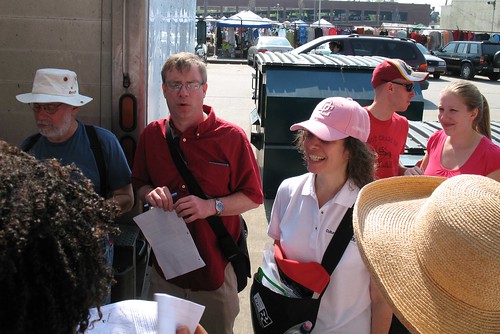
Photo by Mr. T in DC.The tour leaders for today's WalkingTown DC Florida Market tour, discussing the history and importance of the market. In the middle is noted local blogger and preservationist Richard Layman, and in the pink hat is Jane Levey of Cultural Tourism DC.
Because I didn't see the obituary until Saturday ("Paul Pascal, lawyer dubbed 'Mayor of the Market' for efforts to preserve Union Market dies at 80," Washington Post), I missed the funeral of Paul Pascal, a city lawyer-entrepreneur who is the primary person who "saved" Union Market from demolition.
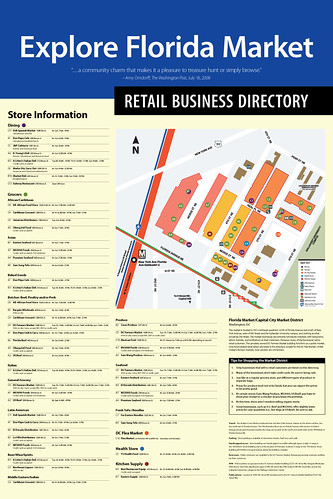 Designer: Christopher Taylor Edwards. Sadly, most of the businesses listed in this directory are gone. Those that have survived moved to Prince George's County, but many others just shut down completely.
Designer: Christopher Taylor Edwards. Sadly, most of the businesses listed in this directory are gone. Those that have survived moved to Prince George's County, but many others just shut down completely.I mean, I helped, and brought a lot of attention to the matter ("Is the Florida Market going down?") including the creation of directories with Christopher Taylor Edwards.
But the reality was that Paul understood how the city's politics and business community worked and was better positioned to make the difference.
Sadly, I don't have a photo of when he and his wife, Brenda, came to speak to one of the tours that Elise Bernard (Frozen Tropics), Ken Firestone, and I led of the market district with CulturalTourism DC's "Walking Town" program, where we had about 150 people at the outset of that particular tour.
After preventing the urban renewal plan from going forward, Paul worked with the various property interests in Union Market in forging its future.
He was a lawyer who specialized in representing small businesses, because he started his law practice in an office space lent to him by his father in law, who owned a chicken distribution business based in the Union Market district of DC.
Among his client groups were liquor licensees, and we were on opposing sides in such matters earlier in the decade, but we worked fine together on this.
He also did various public service gigs, including service as chair of the Capitol Hill Business Improvement District, and as an officer and board member of Ready, Willing & Able, a nonprofit worker readiness, development and employment program (this organization is often contracted by city BIDs for cleanliness services).
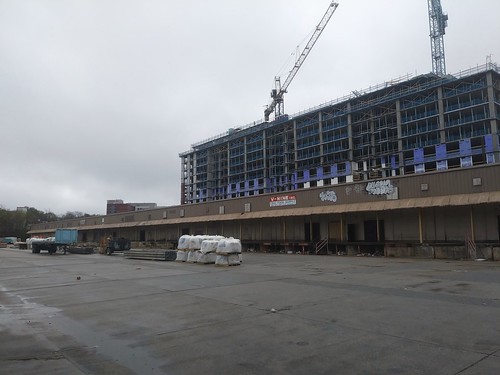 Last time we talked was last spring, over the creation of a BID type initiative there, and I talked to him about my ideas for a consolidated NoMA "public improvement district" ("Public improvement districts ought to be created as part of transit station development process: the east side of NoMA station as an example"). We talked about the "anti-gentrification" lawsuits waged against the market ("How Union Market Has Become The Front Line Of D.C.'s Activist-Developer War," Bisnow) and other stuff like the creation of a VRE train storage yard and how it could affect New York Avenue.
Last time we talked was last spring, over the creation of a BID type initiative there, and I talked to him about my ideas for a consolidated NoMA "public improvement district" ("Public improvement districts ought to be created as part of transit station development process: the east side of NoMA station as an example"). We talked about the "anti-gentrification" lawsuits waged against the market ("How Union Market Has Become The Front Line Of D.C.'s Activist-Developer War," Bisnow) and other stuff like the creation of a VRE train storage yard and how it could affect New York Avenue.We both agreed that the lawsuit didn't have merit, because the new housing being built is 100% new addition, which did not come at the expense of pre-existing housing.
Because of the obituary, I went over yesterday to take some photos. I'd been there earlier in the week, but didn't really shoot anything.
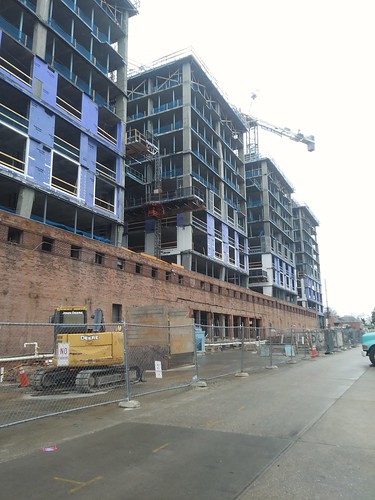 The old Washington Cash and Carry building is the base of this apartment complex.
The old Washington Cash and Carry building is the base of this apartment complex.It reminded me of something I said more than 10 years ago to a Gallaudet student in response to a question. I made the point that with the urban renewal initiative on the table, even though that particular initiative failed, it put the district into play.
And now, major developers are at work and the old "market district" will soon enough be no more.
Despite my efforts and hopes, the reality was that given the insertion of the NoMA Metrorail station into the area, and the proximity of almost 30 acres of redevelopable space a few blocks from a new transit station, the funky wholesale-oriented market was not going to last. I called it in 2008, with an idealized retail district planning vision ("Retail planning and the Florida Market"). A Trader Joe's was suggested, and it opened within the last couple weeks.
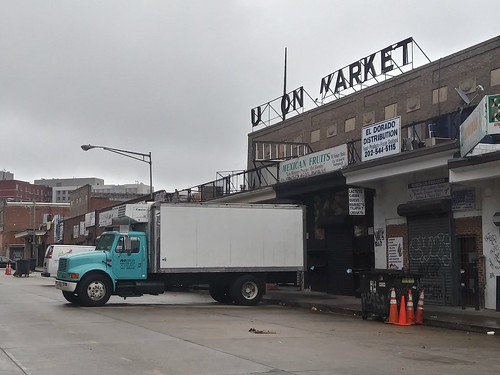 The section of businesses on Morse Street Extended is all shut down. They are building housing where Washington Cash and Carry was, even though they saved the façade.
The section of businesses on Morse Street Extended is all shut down. They are building housing where Washington Cash and Carry was, even though they saved the façade. The old Union Market sign is in need of restoration. Fifth Street NE.
Over time, the rest of the market district will be demolished in favor of new and larger buildings as the new buildings under construction now get "absorbed by the market."
Given DC's relatively paltry amount of developable land, it's not likely that a traditional industrial market district comparable to Pittsburgh's Strip District, Detroit's Eastern Market, or Philadelphia's Italian Market could have stayed in business. But some of the businesses could have been relocated elsewhere in the city.
And Chicago is but one example of a food industry incubation program, which provides decent industrial jobs for people who don't have advanced educations ("Chicago incubators helping food entrepreneurs grow," Crain's Chicago Business). From the article:
Chicago, long a consumer-packaged-goods powerhouse, has become ground zero for services that help food entrepreneurs grow in a supportive, low-risk environment.The Hatchery is a good example of a broader based industrial support effort as an anchor of more intricate community economic development strategies.
Several new ones are in soft-launch mode, including Pilotworks, a shared kitchen and culinary incubator that has taken over the River North space vacated by the now-defunct Le Cordon Bleu cooking school; the Hatchery, a food and beverage incubator that's building a $34 million facility in East Garfield Park; and Springboard, Kraft's in-house startup boot camp that will welcome its inaugural class in September. ...
The Hatchery, slated to formally open in December, already has 60 members who will use the space for a variety of work: as the commissary kitchen for their catering businesses; the production site for their cereals, juices and other packaged products; the R&D space for their new ideas; or the kitchen for their food trucks.
The incubator was born of a similarly varied set of problems that food businesses with less than $10 million in revenue frequently encounter. "The first was the lack of resources and the lack of production space for food," says Hatchery CEO Natalie Shmulik, an industry vet who has run a restaurant, worked for supermarket chains and served as a consultant to growing packaged-goods companies.
The Hatchery offers shared kitchens and private production space to provide flexibility as members expand. For companies that have grown beyond a couple hundred thousand dollars in revenue and need 30 or more hours a week in a kitchen, a private, 24-hour-accessible space is more economical and practical than paying by the hour in a shared space, Shmulik says. "When entrepreneurs outgrow their own kitchens, they have few options beyond investing a huge amount of their own money in a co-manufacturer or commercial kitchen. There's also a shortage of trained production workers, so we're working with the Rick Bayless Institute to train people who haven't had the most success in traditional educational systems."
To my way of thinking, incubators, especially in DC, are focused on short term assistance, when startups and growing businesses need different kinds of assistance as they grow, and they don't stop needing assistance once some artificial milestone date has passed.
The building that became the new Union Market


The scene outside Union Market - Fifth Street, NE, A.D. Handy Co. lantern slide hand-dated 4/23/1940.

Labels: building a local economy, building regulation, economic development, electoral politics and influence, food-agriculture-markets, protest and advocacy, urban design/placemaking, urban revitalization, zoning



0 Comments:
Post a Comment
<< Home